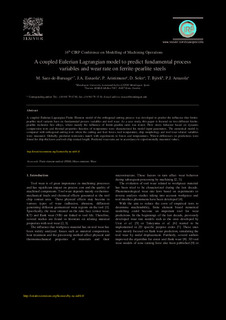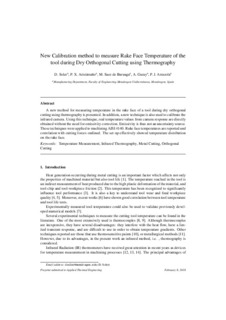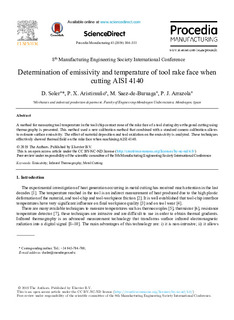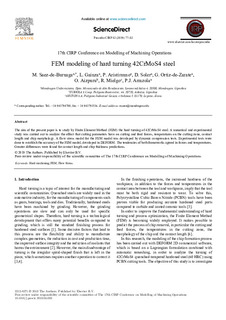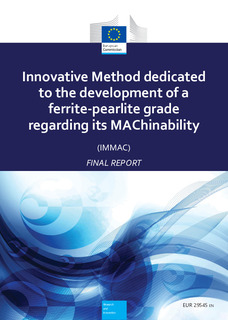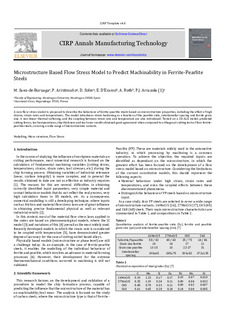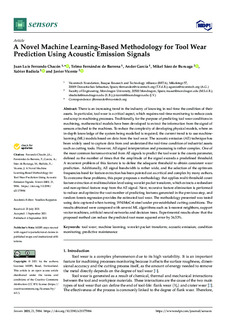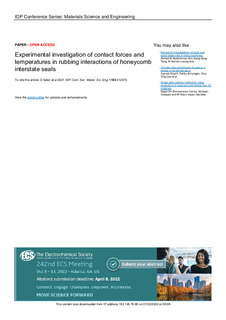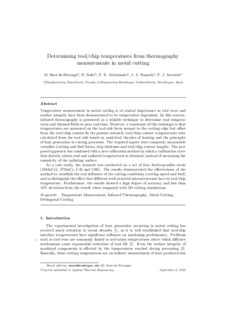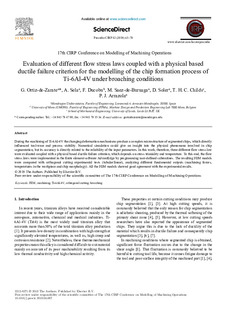Bilatu
14-tik 1-10 emaitza erakusten
A Coupled Eulerian Lagrangian Model to Predict Fundamental Process Variables and Wear Rate on Ferrite-pearlite Steels
(Elsevier B.V., 2017)
A coupled Eulerian-Lagrangian Finite Element model of the orthogonal cutting process was developed to predict the influence that ferritepearlite steel variants have on fundamental process variables and tool wear. As a case ...
New Calibration method to measure Rake Face Temperature of the tool during Dry Orthogonal Cutting using Thermography
(Elsevier Ltd., 2018)
A new method for measuring temperature in the rake face of a tool during dry orthogonal cutting using ther-
mography is presented. In addition, a new technique is also used to calibrate the infrared camera. Using ...
Determination of emissivity and temperature of tool rake face when cutting AISI 4140
(Elsevier B.V., 2019)
A method for measuring tool temperature in the tool/chip contact zone of the rake face of a tool during dry orthogonal cutting using thermography is presented. This method used a new calibration method that combined with ...
FEM modeling of hard turning 42CrMoS4 steel
(Elsevier B.V., 2019)
Innovative Method dedicated to the development of a ferrite-pearlite grade regarding its MAChinability (IMMAC): final report
(Oficina de Publicaciones de la Unión Europea, 2019)
Ferrite-pearlite (FP) steels are the most common material for engineering and automotive industries (gear box parts, crankshaft, connecting rods, injection parts…). Without any extensive research, considering the different ...
Microstructure based flow stress model to predict machinability in ferrite–pearlite steels
(Elsevier Ltd., 2019)
A new flow stress model is proposed to describe the behaviour of ferrite–pearlite steels based on microstructure properties, including the effect of high strains, strain rates and temperatures. The model introduces strain ...
A novel machine learning‐based methodology for tool wear prediction using acoustic emission signals
(MDPI, 2021)
There is an increasing trend in the industry of knowing in real-time the condition of their assets. In particular, tool wear is a critical aspect, which requires real-time monitoring to reduce costs and scrap in machining ...
Experimental investigation of contact forces and temperatures in rubbing interactions of honeycomb interstate seals
(IOP Publishing, 2021)
The new architecture of high velocity aircraft engines includes labyrinth-honeycomb interstate seals to improve the engine’s stability. To increase these engines capacity a commonly used strategy is to reduce the clearance ...
Determining tool/chip temperatures from thermography measurements in metal cutting
(Elsevier, 2018)
Temperature measurement in metal cutting is of central importance as tool wear and surface integrity have been demonstrated to be temperature dependent. In this context, infrared thermography is presented as a reliable ...
Evaluation of different flow stress laws coupled with a physical based ductile failure criterion for the modelling of the chip formation process of Ti-6Al-4V under broaching conditions
(Elsevier, 2019)
During the machining of Ti-6Al-4V the changing deformation mechanisms produce a complex microstructure of segmented chips, which directly influenced tool-wear and process stability. Numerical simulation could give an insight ...


